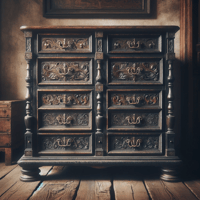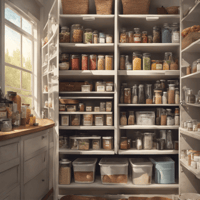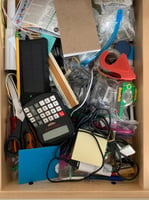Moving to a new house with a walk-in closet is an exciting venture, especially for those who love...
What’s the First Thing to Remove When Decluttering
Decluttering a home can be a transformative and liberating experience. It's not just about tidying up; it's about creating a space that reflects you, promotes well-being, and simplifies your life. Whether you're preparing for a move, seeking to simplify your living environment, or just looking to regain control over your space, the process of decluttering begins with a single step. This journey towards a more organized and harmonious living space starts with careful consideration of what to remove first. By understanding where to begin and why, you can kickstart your decluttering efforts and pave the way for a more clutter-free and stress-free living space. So, what’s the very first thing you should remove when you begin your decluttering project: Expired or spoiled items.
Expired or Spoiled Items
When it comes to decluttering, the first stop on our journey is the kitchen, and specifically, dealing with expired or spoiled items. Why? Well, for starters, these items aren't just clutter; they can pose health risks. Stale crackers, moldy cheese, and those mysterious containers at the back of the fridge that you've been avoiding – they're all potential troublemakers. Beyond the health aspect, these expired or spoiled items can be a real space hog. They take up valuable real estate in your pantry, fridge, and countertops, leaving you with less room for the fresh, delicious ingredients you'd rather have on hand.
Clearing out these items might seem like a small step, but it's a big leap towards a safe and organized kitchen. Think about it as a kitchen detox – you're purging the stuff that's past its prime, making room for healthier, tastier options. Plus, when you know exactly what's in your pantry and fridge, you'll save time and money by avoiding unnecessary purchases and reducing food waste. So, in addition to creating a cleaner, safer kitchen, tackling expired and spoiled items is an investment in your well-being and your culinary adventures. Let's roll up those sleeves and get started!
Once you tackle the most important decluttering, consider items from the following list.
Duplicates
Duplicates clutter your space and make it difficult to find what you need. Start with duplicates because keeping only the essentials streamlines your belongings and makes it easier to maintain an organized home.
Old Magazines and Newspapers
Old magazines and newspapers tend to accumulate and create clutter. Removing them clears visual distractions and creates a cleaner living environment.
Worn or Damaged Clothing
Worn or damaged clothing takes up valuable closet space and can make it difficult to find and wear the clothes you love. By decluttering these items, you free up space for clothing you actually wear and enjoy.
Outdated, Unused or Broken Electronics and Cables
Unused or broken electronics can clutter up your living areas and may even be a fire hazard if left unchecked. Outdated electronics and cables can be confusing and take up drawer space. Decluttering them can make it easier to find the cables and devices you use. Included in this category are the multitude of charging cords that we accumulate. Dump the charging and connection cords that no longer work or fit the devices that you own. Removing these items makes your home safer and more organized.
Expired Medications and Toiletries
Expired medications and toiletries can be ineffective or even harmful if used past their expiration dates. By decluttering these items, you ensure that your bathroom is stocked with only safe and useful products.
Unused Kitchen Appliances
Unused kitchen appliances take up precious counter or cabinet space. Start with these because they are often large and easy to identify as non-essential items.
Excess Décor
Decorative items that no longer match your style or that you no longer love can create visual clutter. By decluttering decor, you create a more cohesive and aesthetically pleasing living space.
Toys and Games
Children's toys and games can multiply rapidly, leading to clutter. By involving your children in decluttering and removing items they no longer play with, you teach them the value of organization and responsibility. This is a great opportunity to donate to charities that can find a new home for them and brighten another child’s day.
Unused Furniture
Unused furniture pieces can make your home feel cramped and disorganized. Removing excess furniture can create more space and improve the flow of your living areas.
Excess Linens
Excess linens can take up closet and storage space. By decluttering linens, you ensure that you have room for the essentials and can maintain a more organized linen closet.
Broken or Unusable Items
Broken or unusable items like pens that don’t work, or old keys serve no purpose and take up space. By addressing them early in your decluttering process, you prevent further clutter buildup.
Starting with these categories of items is like setting the stage for a decluttering success story. It's not just about tackling the low-hanging fruit; it's about building momentum and creating a domino effect of positive change throughout your living space. When you begin by decluttering expired food, duplicates, old magazines, and unused gadgets, you're addressing some of the most straightforward and visually distracting clutter sources.
Once you've tackled these initial categories and experienced the liberating feeling of a cleaner, safer, and more organized living space, you'll be better prepared to handle more sentimental or challenging categories. These might include items with emotional attachments, like old letters, family heirlooms, or childhood memorabilia, which can be harder to part with. Starting with the simpler categories builds your decluttering muscles and provides you with the confidence and motivation to tackle more complex areas.
So, in essence, beginning with these categories is the ideal launchpad for your decluttering journey. It's not just about creating a tidier home; it's about forging a path towards a more streamlined, healthier, and happier living environment. With each item you clear, you're making room for more of what truly matters in your life, be it experiences, relationships, or just the simple joy of having a clutter-free and harmonious home.


